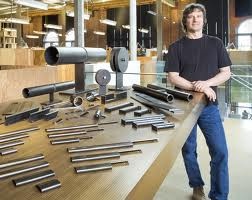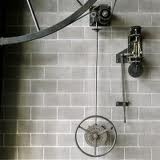Today in the Post: African American Museum to use five-story exterior to screen 3-D video + the Smithsonian webcams!
Category: Culture
Future/Primitive
A dear colleague shared correspondence with me which asks a group of people on a committee for an architectural exhibit to share their thoughts on the theme of the future/primitive in architecture:
“As we have progressed with our theme of Future/Primitive I have begun research into the ideas that are important to the planning committee for this year’s exhibit. As I have done some reading into contemporary thinking around the word “primitive” as used in the architectural field I have found that the use of the word is quite contentious – as it is in other fields of anthropology and cultural studies. I will provide a link to a book I was reading from and I think that the issues I am referring to are clear in the introduction, which is quite short. Would some of you be willing to read it as well and let me know your thoughts?”
Of course, don’t ask me what I think:
I like the passage in the introduction “…architects continue to use the word [primitive] to mythologize and reify the practice of simplicity.” Which also makes me think of authenticity, both the cultural/ephemeral and the material/tectonic…
Hailing from the South, where hushpuppies come free of charge (like chips and salsa do at their “Mexican” restaurant counterparts), I think of Tom Douglas’ foray into another brand of authenticity with his Brave Horse Tavern ca. 2011 in the middle of the new car smell of South Lake Union (see also Local 360, where the only thing local about the idea of grits as a side dish is paying $3.50 for it, which at that price should be called polenta)…
Brave Horse, invoking images like this:

And serving familiar food like this:

Fried chicken? Macaroni salad? Watermelon?
The design response to authenticity may be romance, even nostalgia for the future/primitive, machines we can look at and understand, the opposite of say the iPod ‘back in the day’, if you can recall your own first impression/fascination with the simplicity of it and its iterations, but also your frustration with how something as simple as changing its battery was no longer in your domain, among other things.
At the architectural scale, Tom Kundig’s kinetic architecture may be a response/celebration of machines we can look at and understand and that somehow speak to an authenticity, a transparency about how things work, and beyond, how we live and interact and view the built environment and the world around us vs. say the iPod-class of buildings:
This popular sentiment, to which Sweets Catalog can attest, see their recent product design feature, Practice Makes Products.

Is this new/old aesthetic the primitivization of building products and buildings, the modern analogy to the English Arts & Crafts Movement’s response to the Industrial Revolution?

Perhaps Douglas and Kundig’s is a response or some antidote to the present day revolution already upon us, the Information Age. The future already looks like this:

In the statement accompanying the World Architecture Festival Building of the Year, 2011: “The Industrial Revolution and now the Digital Revolution. Today, in the information age, architecture is a technology platform that consists of computer system connections and new materials. This project has been commissioned by The Consortium of the Zona Franca CZFB and 22 @ of Barcelona. 22@ is an experimental district with a powerful, distributed and accessible, energy load. Part of the Districlima network, where new business values are intangible. We were extremely interested in this digital city model based on ICT (information and communication technology), with the idea of a city where what matters is knowledge, added value and patents, in short, where the objective is for your architecture to be in sync with your own values…”
How can/does the primitive persist in the Information Age? Into that “experimental district with a powerful, distributed and accessible, energy load” ie. eco districts? Or among the Amazonians of South Lake Union?
There must be something about the primitive which represents our longing for authenticity, simplicity, continuity, provenance if not permanence. A memory-grounded anti-Information Age statement via hand-cranked windows and fried chicken, where the currency of information, open-source, virtual social networks and concepts as ephemeral as The Cloud, are held at bay, or in contrast to the dominant paradigm of the day.
If not still fried chicken, what will be the future’s go-to ‘comfort food’? Will we define Kundig as someday charming, quaint, the Delta Shelter making the cover of American Bungalow?
The character “Mater” from the Disney movie Cars, comes to mind. Popular, CORTEN after all, capitalizing on hushpuppies and grits, and a bit of the American nostalgia for a bygone era where people changed their own oil, their own flat, and tinkering on cars was a pastime. And so on…
Is it not that the future/primitive for any generation is an attempt at authenticity when authenticity seems all but lost and some bygone era, a ‘Golden Age’ ala Woody Allen’s Midnight in Paris (2011), gives us hope, respite and perspective, eventually re-grounding us so that we might yet make that next bold step more confidently in the direction of one’s dreams?
Goodwill and the Currency of Childhood
Parade: an organized public procession on a festive or ceremonial occasion
In keeping with their mission to engage and inspire, at the end of yesterday’s performance on the Green in Chapel Hill’s Southern Village neighborhood, Paperhand Puppet Intervention invited the audience to join them in the celebratory ritual of parade.
The crowd was costumed in a U-Haul’s load of masks, under the sway of giant puppets all stomping down Market Street to the rhythm of the drums. I was easily swept up and away. Their mission:
Paperhand Puppet intervention is dedicated to bringing many styles of puppetry and artistic expression to the Triangle area and the world.
These styles include: Giant puppets, masks, stilt dancing, rod puppets, shadows or silhouettes, and anything else we might make at any time.
Our vision is inspired by our love for the earth and its creatures (including humans) as well as our belief in justice, equality, and peace.
We are committed to creating multi-scaled and multi-disciplinary puppet performances that support this vision.
Paperhand’s mission is to make work that inspires people, promotes social change, and is deeply satisfying for everyone involved.
The puppet shows we create are a synthesis of many art forms including (but not limited to):sculpting, painting, music, dance, improvisation, costume/set design and theater.
We are celebrants.
We are activists.
We are puppeteers
Our will is set on undermining, and eventually, eradicating the institutions of greed, hate, and fear that plague the world in myriad forms.
We will work all our lives uncompromisingly to these ends.

The Chatham County Courthouse Fire of 2010
PITTSBORO, NC. A staple landmark for the 20 years I’ve been passing through these parts, the Chatham County Courthouse burns. See more at : http://www.youtube.com/watch?v=pbc1LGRC1ro&feature=player_embedded
1000 Flatpack Prefab Shelters to Haiti
From Inhabitat.com, Andres Duany’s small cabin style home with a simple frame, netted sides and a supported awning based on research by sociologists and anthropologists to refine the design.
North Carolina through the eyes of Masahara Izuka aka George Masa
From Asheville’s Grove Park Inn, the Biltmore House and the likes of John D. Rockefeller, to the Cherokee people, the founding of the Great Smoky Mountains National Park and the charting of the Appalachian Trail…
…Imagine that, an outlier of Asian decent, to some then “good for business”, to us all now good for North Carolina.
Gaining acceptance deep in the heart of Appalachia through nothing less than a genuine, heartfelt respect of the ways of life of others. And connected, like no one else to this beautiful little patch of planet…hike on, George.
Geothermal and the desecration of Pele, the native goddess of fire and volcanoes
From the NYTimes: Hawaii Tries Green Tools in Remaking Power Grids, I found it fascinating and curious the notion that geothermal electricity generation might be thought of as sacrilegious to some.
“…As in any state with a rural-urban divide, residents of Hawaii’s less populous outlying areas are wary about being pushed around by planners in Honolulu.
The outer islands have higher concentrations of Native Hawaiians who are well versed in a local history of exploitation, from the American overthrow of their monarch in 1893 to environmental costs of sugar plantations and tourism. “

“Some have formed groups like the Pele Defense Fund, which sprang up here in the 1980s to protect religious gathering rights in the rain forest on the Big Island. The fund seeks to prevent desecration of Pele, the native goddess of fire and volcanoes, and finds geothermal energy projects sacrilegious.”













